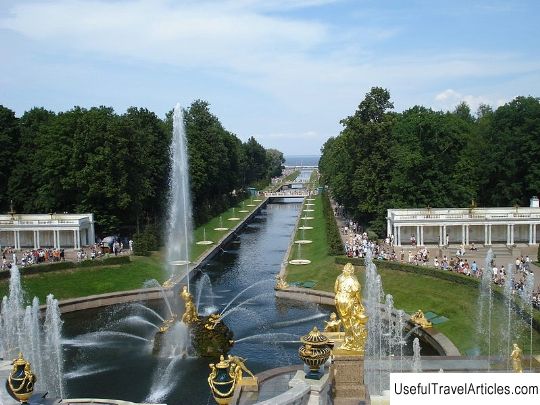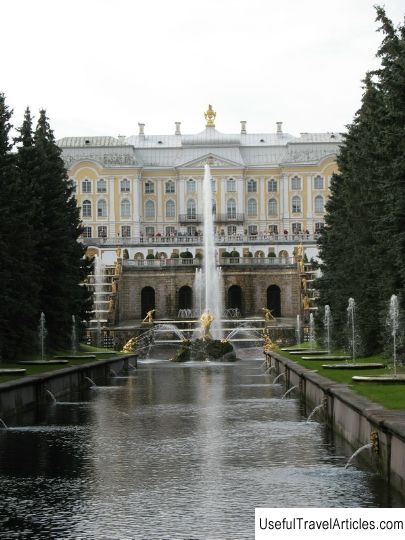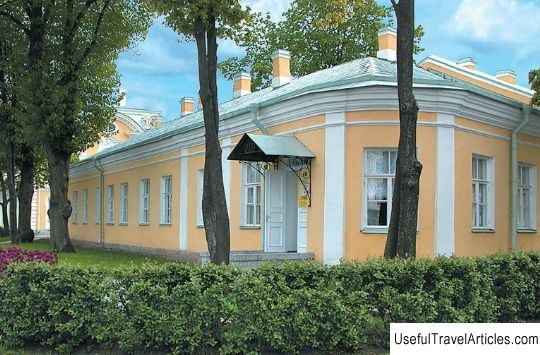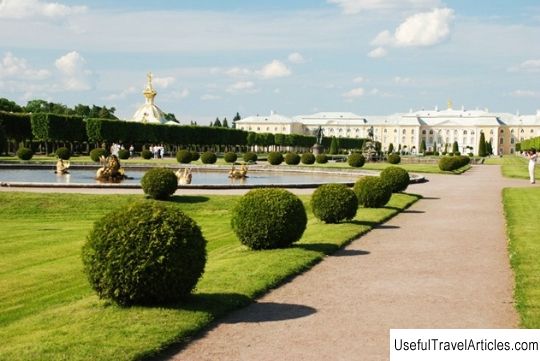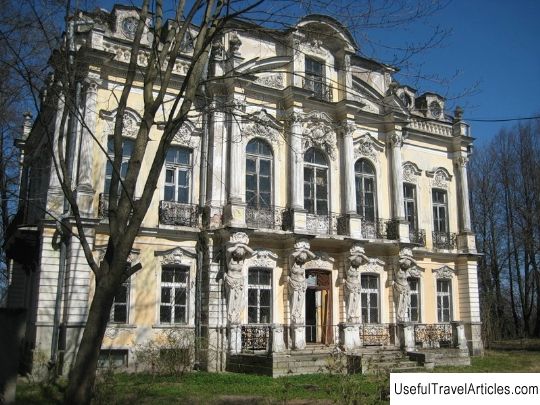Peterhof - an ensemble of palaces and parks description and photos - Russia - St. Petersburg: Peterhof
Rating: 8,2/10 (3785 votes) 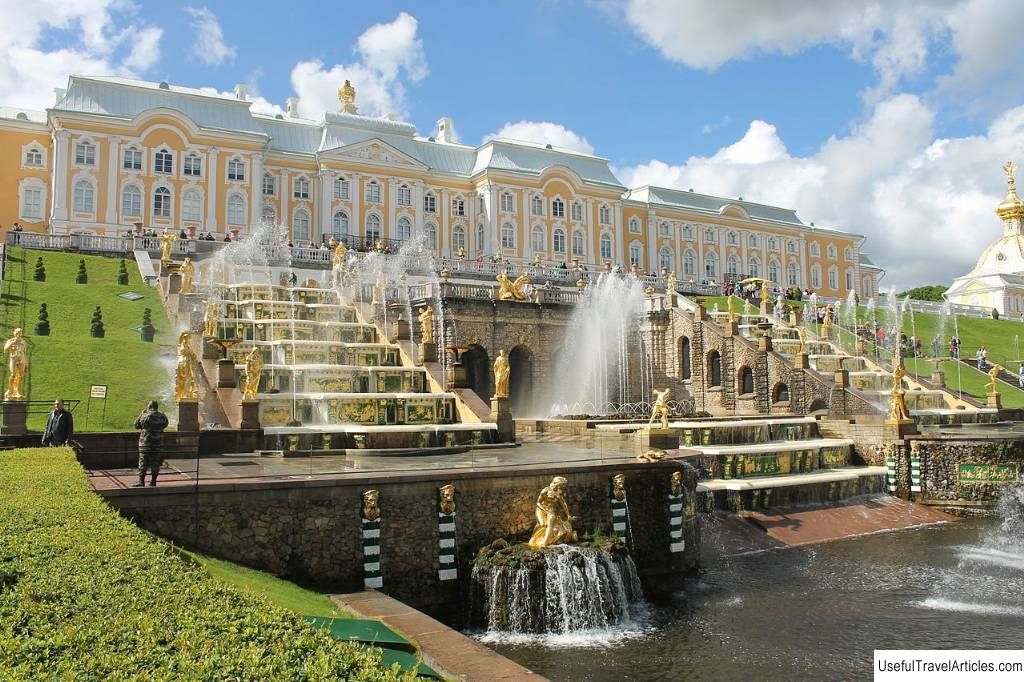
Peterhof - an ensemble of palaces and parks description and photos - Russia - St. Petersburg: Peterhof. Detailed information about the attraction. Description, photos and a map showing the nearest significant objects. Photo and descriptionThe huge ensemble of Peterhof is the most famous and most magnificent of the suburbs of St. Petersburg, the long-standing residence of the imperial house. Its visiting card is the famous fountains, but besides them, you can see several palaces built for different emperors and members of their families, numerous park pavilions, ponds, churches, etc. Lower ParkThe history of Peterhof began with Peter I . Before him there were several Finnish villages, and Peter decided to build himself a small traveling palace, where he could stop on the way to Kotlin Island . Here in 1714 a grandiose park with a palace and fountains was laid. A Grand Palace appeared on the shores of the Gulf of Finland, and between it and the Gulf there was a canal dug. A park has emerged along the banks of the canal, and a system of fountains is arranged on the terraces that rise to the palace, which are rightfully considered the most beautiful in the world. Here on two cascading staircases there are seventy-five fountains and two hundred and fifty-five statues decorating them, as well as two grottoes . Under the Grand Cascade is the most famous statue of Peterhof - Samson, tearing the mouth of a lion. In addition to the Grand Cascade, there is also the Golden Mountain Cascade and several separate groups of fountains located in the park. One of the expositions of the Grand Palace is dedicated to the history and structure of these fountains. For himself, Peter built a small palace called "my pleasure" - Monplaisir . It was built in accordance with the personal drawings and wishes of the king: on the very shore of the bay, very small, but very comfortable. The palace was decorated according to the latest technology, for example, a plumbing was installed in the kitchen with sinks for washing dishes. Now here, in addition to the collections of paintings and Chinese porcelain that Peter I collected for himself, you can see some of his personal belongings: a washbasin, a nightcap and others. In front of the palace, the famous fire fountains were arranged, in the form of benches in the garden. Anyone who sat on such a bench was immediately doused with a stream of water. Now the fountains are working and in hot weather they serve as entertainment for tourists. These are not the only comic fountains in the Lower Park of the Peterhof Palace - for example, there is a oak-shaped fountain painted like a natural tree, an umbrella-shaped fountain, under which it is impossible to hide from water, and others. Under Elizabeth a small new building was added to Monplaisir specially for her, and under Catherine II, the architect D. Quarenghi it was completed and decorated. It houses a museum exposition telling about the life of the palace, but at the moment the building is being restored and the museum is closed. For the sickly Maria Fedorovna , wife of Alexander II, a whole complex for hydrotherapy was built here - Bath building . It had a steam room, rooms for warm and cold baths, etc. Now there is a museum , where you can see the interiors of the middle of the 19th century, and reproduce some comic bath fun dating back to Peter I. Another small guest palace, built under Peter I - Marley . It is located on the bank of the Marly pond , where fish were once raised. Under the next Romanovs, it was used as a rest house and as a memorial house of Peter I - his personal belongings were preserved here. Now in the museum you can see them, interior items of Peter's time and a collection of Western European paintings. The Grand Palace under Peter I himself was also simple and small. He owes his current appearance to his daughter Elizabeth - it was she who commissioned the architect F. Rastrelli to rebuild the palace in the Baroque style. The interiors were also designed by F. Rastrelli. They are decorated with sculptures, carvings, stuccoes and paintings. The main hall is decorated with the painting "Allegory of Spring" - in fact, it is an allegory glorifying the kingdom of Elizabeth. The Empress loved balls - and the entire western wing was almost entirely occupied by a huge dance hall. In the east wing in 1751 there was the court church of Peter and Paul . It has an unusual octagonal layout and is richly decorated with Elizabeth's gold ornaments and monograms. The church has been operating since 2011, in the refectory you can see an exhibition telling about its history. The interior of the palace also changed under the following rulers. Under Catherine II the famous Chesme Hall appeared. Here were collected paintings in honor of the victory of the Russian fleet in 1770. Under Catherine, a lover of various oriental exotics, Chinese offices , decorated with lacquer screens, appeared in the palace. In addition to authentic Chinese objects, European stylizations imitating Chinese art were collected here - for example, English and French furniture decorated with inlays and lacquer paintings. Under Catherine, the interior of one of the central halls was renewed, and it was turned into a Picture Hall with a large collection of paintings by the court portrait painter P. Rotary . Precious relics of the entire Romanov dynasty: commemorative cups, snuff-boxes, rings, dishes with coats of arms and monograms, dresses of empresses and uniforms of emperors, products of the famous Faberge company - can be seen in the Special Storeroom exposition, which is located in the personal chambers of Catherine II. The park continues to be improved by Alexander I . Under him, the old wooden galleries in front of the Grand Palace were dismantled, in which there were also various water ideas. Architect A. Voronikhin here creates Empire colonnades decorated with figures of lions. Alexandria The second complex of Peterhof buildings was created already under Nicholas I. This is Alexandria Park , named after his beloved wife Alexandra Feodorovna . It was this place that became the summer residences of the Romanov family in the 19th century. The neo-Gothic Cottage Palace became the main building. Its interiors have been almost completely preserved, and now there is a museum exposition telling about Nicholas I and his wife. Not far from him a farm was set up, which soon became the Farm Palace . There was indeed a small dairy farm that supplied the emperor's family with fresh milk. The stone building was disguised as a wooden one: the roof was painted to look like straw, and the Empire columns imitated birch trunks. With the birth of the heir, special living rooms were added here for him, and the cowshed was moved. The matured Alexander II made this place his favorite summer residence. The current exposition tells about his life here: his study, the private chambers of Empress Maria Feodorovna and much more have been preserved. Once there was a grandiose playground for his children: a mill, his own farm, a country house. From all this, now in the park you can see a children's fire tower, arranged according to all the rules. On the second floor of the palace there is an exposition dedicated to the Peterhof dachas and summer residents of the 19th-20th centuries. In 1834, a Gothic chapel - the house church of Nicholas I appeared in the park. This is the Orthodox church of St. Alexander Nevsky, but it was built in such a way that it is like a Gothic cathedral in miniature. Now it is consecrated and in operation. Another place that testifies to the love of the emperor for his wife is the Tsaritsyn Pavilion . Initially, there was a swamp here, but it has turned into a landscaped pond with artificial islands. Two romantic pavilions in the antique style were built on two islands: Tsaritsyn for Alexandra Feodorovna and Holgin for her daughter, Princess Olga Nikolaevna. Both islands are now museums. Interesting factsOriginally, the pipes for the water supply for the fountains were made of wood. In the 19th century, they were replaced by metal ones - many of these pipes are still in use. The favorite flower of Empress Alexandra Feodorovna was roses. Now in the garden of the Tsaritsyn pavilion there are blooming roses of ancient varieties - those that once could grow with her. The oldest watch factory in Russia is located in Peterhof. It was founded by Peter I in 1725 as a gem cutting workshop. Now the factory continues to operate and in 2015 produced the world's largest watch. NotesLocation: St. Petersburg, Peterhof, st. Razvodnaya, 2. How to get there: by train from the Baltic Station or by meteor from the Palace Embankment. Official website: https://peterhofmuseum.ru/ Working hours. Lower Park and the Grand Palace: 09: 00-21: 00, museum expositions in pavilions and other palaces 10: 00-18: 00, fountains work from 11:00. Ticket prices: Lower Park. Adult 450 rubles, concessionary - 250 rubles. Grand Palace. Adult - 450 rubles, reduced price - 300 rubles. Entrance to expositions in pavilions and other palaces is paid separately.                   We also recommend reading Cathedral of San Maurizio (Cattedrale di San Maurizio) description and photos - Italy: Empire Topic: Peterhof - an ensemble of palaces and parks description and photos - Russia - St. Petersburg: Peterhof. |
